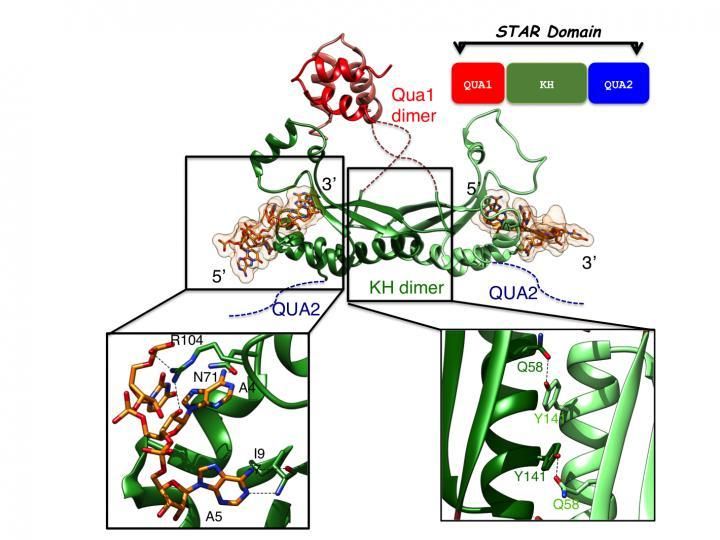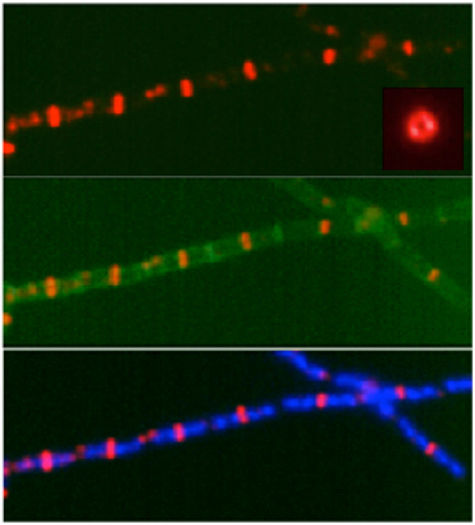New study creates first 3-D vision of cancer target
A team from the University of Leicester has for the first time published a detailed description of a protein linked to many types of cancer.

Top: Overview of the structure of T-STAR STAR domain in complex with AUUAAA RNA. Bottom left: close up view of the specific recognition of the RNA. Bottom right: close up view of the KH dimerization interface.
University of Leicester
The lab-based study from the Department of Molecular and Cell Biology now provides an opportunity for scientists to develop drugs to target this protein.
Dr Cyril Dominguez who led the work at Leicester said: "My research field is structural biology. The proteins that we have studied, called Sam68 and T-STAR, are very similar and overexpression of Sam68 has been shown to correlate with poor prognosis in many types of cancers.
"Our results provide atomic resolution details on how Sam68 binds specifically to its RNA target. Furthermore, we show that Sam68 forms a homodimer that has never been described before and is crucial for its function in RNA splicing.
"This is important because this basic research set the grounds for structure-based drug design approaches. If we can identify or design drugs that bind specifically at the dimerization interface, we will be able to prevent the function of these proteins in cells, which could have implications for novel cancer treatments.
"Now that we have a high-resolution structure of Sam68 and T-STAR and a high-throughput binding assay, we are in discussion to collaborate with a major drug discovery consortium to screen a very large library of compounds to inhibit the function of Sam68."
Original publication
Mikael Feracci, Jaelle N. Foot, Sushma N. Grellscheid, Marina Danilenko, Ralf Stehle, Oksana Gonchar, Hyun-Seo Kang, Caroline Dalgliesh, N. Helge Meyer, Yilei Liu, Albert Lahat, Michael Sattler, Ian C. Eperon, David J. Elliott & Cyril Dominguez; "Structural basis of RNA recognition and dimerization by the STAR proteins T-STAR and Sam68"; Nature Comm.; 2016
Original publication
Mikael Feracci, Jaelle N. Foot, Sushma N. Grellscheid, Marina Danilenko, Ralf Stehle, Oksana Gonchar, Hyun-Seo Kang, Caroline Dalgliesh, N. Helge Meyer, Yilei Liu, Albert Lahat, Michael Sattler, Ian C. Eperon, David J. Elliott & Cyril Dominguez; "Structural basis of RNA recognition and dimerization by the STAR proteins T-STAR and Sam68"; Nature Comm.; 2016
Organizations
Other news from the department science

Get the life science industry in your inbox
By submitting this form you agree that LUMITOS AG will send you the newsletter(s) selected above by email. Your data will not be passed on to third parties. Your data will be stored and processed in accordance with our data protection regulations. LUMITOS may contact you by email for the purpose of advertising or market and opinion surveys. You can revoke your consent at any time without giving reasons to LUMITOS AG, Ernst-Augustin-Str. 2, 12489 Berlin, Germany or by e-mail at revoke@lumitos.com with effect for the future. In addition, each email contains a link to unsubscribe from the corresponding newsletter.
Most read news
More news from our other portals
Last viewed contents
Infectious_disease

Deloitte recognizes Cytena’s extraordinary and continuous revenue growth

Atomic insights into plant growth - Researchers from Tübingen resolve how a plant steroid hormone makes plants grow
Harold_Ridley_(ophthalmologist)
Evergreens and hot topics: ACHEMA preparations shift into high gear

ST Instruments B.V. - Shedrecht, Netherlands
-phob-
Innate immunity - When DNA is out of place

Protein that delays cell division in bacteria may lead to the identification of new antibiotics


















































